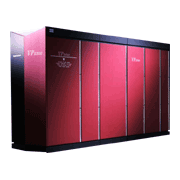The FUJITSU VP2000 Series was announced in December 1988 as the successor of Fujitsu's FACOM VP Series E Model supercomputers. The series had the following features:
- By using state-of-the-art ultra high-speed, high-density LSI, it achieved the world's highest speed of 5 gigaFLOPS for a single CPU.
(FUJITSU VP2600/10) - Expanded parallel execution capability for improved effective performance (about 3 times that of the FACOM VP-400E)
- Equipped with two general-purpose arithmetic pipelines (This enabled parallel operation with any combination of: addition, multiplication, multiplication & addtion, logical operation. The FACOM VP Series E Models could not perform the parallel operation of two multiplications.)
- An enhanced mask pipeline enabled parallel processing of mask operations.
- Enhanced division pipeline processing performance (Division instructions executed about 5 times faster than with the FACOM VP Series E Models.)
- System flexibility and economy were achieved by using the DSP (Dual-Scalar Processor) system.
- New multiprocessor in which two scalar units share a single vector unit
(There is no need for software to be aware of the fact that the vector unit is shared, so the vector unit usage rate is improved.) - Easy to perform a field upgrade from a single processor configuration to the DSP (Dual-Scalar Processor) configuration (Just add a scalar unit)
- New multiprocessor in which two scalar units share a single vector unit
- The series achieved improved system throughput and input/output performance using newly employed system storage.
- -System storage unit capable of data transfer with the main storage unit
- High-speed transfer capability with a large capacity of 8 gigabytes maximum (2 gigabytes/second for transfer from storage memory to main storage, and 1 gigabyte/second for transfer from main storage to system storage)
- Used as a swap area for vector processing, and input/output virtual files
- Space-saving, power-saving
- The series reduced installation area to about 3/4, and power consumption to about 2/3, of the VP Series E Models.
| VP2100/10 VP2100/20 |
VP2200/10 VP2200/20 |
VP2400/10 VP2400/20 |
VP2600/10 VP2600/20 |
||||
|---|---|---|---|---|---|---|---|
| Announcement date | December 1988 | ||||||
| Max. vector performance (GFLOPS) | 0.5 | 1 | 2 | 5 | |||
| Vector processor | Number of VUs (Vector Units) | 1 | |||||
| Number of SUs (Scalar Units) | VP2100/20,2200/20,2400/20,2600/20: 2 | ||||||
| VP2100/10,2200/10,2400/10,2600/10: 1 | |||||||
| Vector register capacity | 32KB/SU | 64KB/SU | 128KB/SU | ||||
| Vector pipelines | Number | 5 | 7 | ||||
| Throughput | 1 | 2 | 4 | ||||
| Pipelines that can operate in parallel | 4 | 6 | |||||
| Buffer storage capacity | 128KB/SU | ||||||
| Main elements | ECL LSI with 15,000gates/chip and delay time of 70ps/gate | ||||||
| Access time 1.6nanosec. 64Kbit RAM + 3,500 gate RAM & logic LSI | |||||||
| Main storage unit | Memory element | 1Mbit static RAM, access time 35nanosec | |||||
| Unit | Capacity (MB) | 32-1024 | 64-1024 | 128-1024 | 256-2048 | ||
| System storage capacity (GB) | 1,2,4,6,8 | ||||||
| Max. number of provided channels | 128 | ||||||
(Note) The above specifications are from the time of announcement, and may have been changed due to later improvement.


